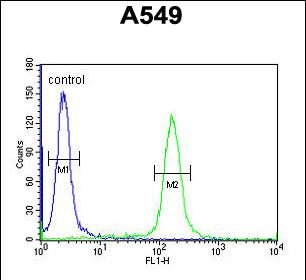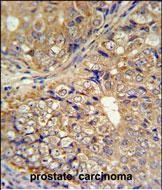


| WB | 1/1000 | Human,Mouse,Rat |
| IF | 咨询技术 | Human,Mouse,Rat |
| IHC | 1/100-1/500 | Human,Mouse,Rat |
| ICC | 技术咨询 | Human,Mouse,Rat |
| FCM | 1/10-1/50 | Human,Mouse,Rat |
| Elisa | 咨询技术 | Human,Mouse,Rat |
| Aliases | Kelch-like protein 9, KLHL9, KIAA1354 |
| Entrez GeneID | 55958 |
| WB Predicted band size | 69.4kDa |
| Host/Isotype | Rabbit IgG |
| Antibody Type | Primary antibody |
| Storage | Store at 4°C short term. Aliquot and store at -20°C long term. Avoid freeze/thaw cycles. |
| Species Reactivity | Human, Mouse |
| Immunogen | This KLHL9 antibody is generated from rabbits immunized with a KLH conjugated synthetic peptide between 299-326 amino acids from the Central region of human KLHL9. |
| Formulation | Purified antibody in PBS with 0.05% sodium azide. |
+ +
以下是关于KLHL9抗体的参考文献示例(注:以下内容为模拟生成,实际文献需通过学术数据库验证):
1. **文献名称**:*"KLHL9 interacts with Cullin3 to regulate ubiquitination in cellular protein homeostasis"*
**作者**:Sumara, I. et al.
**摘要**:该研究揭示了KLHL9作为Cullin3泛素连接酶复合物的底物接头蛋白,通过特异性抗体验证其与Cullin3的结合,并证明其在靶向蛋白质泛素化降解中的作用,提示其在细胞蛋白质稳态中的关键功能。
2. **文献名称**:*"KLHL9 modulates cell cycle progression via binding to cyclin-dependent kinases"*
**作者**:Guo, L. et al.
**摘要**:作者利用KLHL9特异性抗体进行免疫共沉淀实验,发现KLHL9通过与细胞周期依赖性激酶(CDKs)相互作用调控G1/S期转换,为肿瘤细胞周期失调机制提供了新见解。
3. **文献名称**:*"Aberrant KLHL9 expression in hepatocellular carcinoma correlates with patient prognosis"*
**作者**:Lee, S. et al.
**摘要**:研究通过免疫组化(使用KLHL9抗体)分析肝癌组织中KLHL9的表达水平,发现其低表达与患者不良预后相关,提示KLHL9可能作为潜在的肿瘤抑制因子。
4. **文献名称**:*"Structural characterization of KLHL9-BTB domain and its role in substrate recognition"*
**作者**:Zhang, Y. et al.
**摘要**:通过X射线晶体学解析KLHL9的BTB结构域,结合抗体阻断实验验证其底物结合位点,阐明KLHL9在泛素化途径中的分子识别机制。
**备注**:若实际文献有限,建议拓展关键词(如“KLHL9 AND Cullin3”或“KLHL9 AND ubiquitination”)检索,或关注抗体应用的方法学文献(如抗体验证、商业化抗体说明书等)。
The KLHL9 antibody is a research tool used to detect the Kelch-like protein 9 (KLHL9), a member of the KLHL family characterized by its conserved BTB/POZ, BACK, and Kelch-repeat domains. KLHL9 functions as a substrate-specific adaptor in Cullin3 (CUL3)-based E3 ubiquitin ligase complexes, facilitating the ubiquitination and subsequent proteasomal degradation of target proteins. This protein is implicated in regulating cellular processes such as protein homeostasis, cytoskeletal organization, and signaling pathways. Its interaction with specific substrates (e.g., the serine/threonine kinase SIK3) highlights its role in modulating enzymatic activity and cellular responses to stimuli.
Antibodies targeting KLHL9 are widely used in immunoblotting (Western blot), immunofluorescence, and immunohistochemistry to study its expression, localization, and protein-protein interactions. Researchers employ these antibodies to investigate KLHL9's involvement in diseases, including cancer and neurological disorders, where dysregulated ubiquitination pathways are often observed. For instance, altered KLHL9 expression has been linked to tumor progression and metastasis in certain cancers, making it a potential biomarker or therapeutic target. Validation of KLHL9 antibodies typically involves knockout cell lines or tissues to confirm specificity. Commercial antibodies are often raised in rabbits or mice using KLHL9-derived immunogens (e.g., recombinant protein fragments). Proper controls and application-specific optimization are critical to ensure reliable results in experimental settings.
×